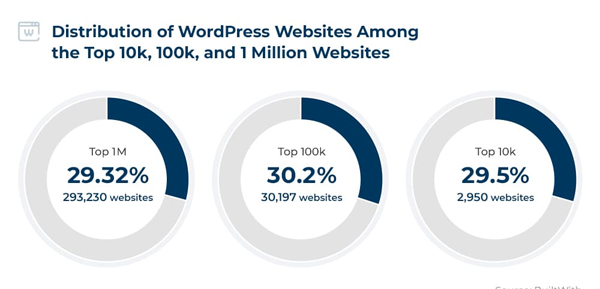How to Create the Perfect WordPress Site Structure for SEO
“When you build a site with WordPress, the structure is highly customizable.”
Chris Lema (WordPress Developer & Blogger)
How often do you make the effort to scroll down and go through different search engine result pages when you search for something on Google? Let me answer this question with a fact, 99% of all clicks are captured by the first page of all results. (Demandsage: SEO Statistics)
So, what can you do to enhance your search engine discoverability? For me, the most effective solution for this is to frame a good site structure. It not only yields better search results but also improves UX.
I know some of you might find this task complicated or even boring, but with WordPress, this is not the case. Its user-friendly features simplify the process of optimizing the site structure for SEO. In this guide, I will explain the impact of a good site structure and also share with you seven simple steps for WordPress site optimization.
Why You Need Proper SEO Website Structure
I am sure website structure is not the first thing that comes to your mind when you hear about SEO. You might question ‘What is the need of it’? Here is an important thing to remember — search engines are algorithms. That’s why they love structure. And if you provide them with some decent WordPress architecture, they will love your website. How does it work, though?
First off, an optimized structure improves crawlability of the site. To put it in simple words, this means that search engines can discover and index your pages easier. Besides, it helps spread link equity (aka juice) across different links better. Finally, good architecture helps crawlers better understand the context of your content so they can recommend it to more users with relevant questions.
If we talk about the UX, a clear site structure also allows people to navigate your website faster. Why does this matter? Well, because users feel better when interacting with your page. As a result, you can significantly enhance your customer satisfaction rate, sales, and overall brand image.
Remember that, this doesn’t mean that you have to ignore other SEO aspects if you get your sitemap right, not at all. But it is an essential foundation that will help you a lot further down the road.
Even if you do link building, you have to make sure that your site structure helps you maximize the effects and provides you with the most of that link juice. Then, all that’s left is to find good Indian backlinks (or any other location relevant to your business) and avoid getting mentions with unnatural anchors. And you’re golden!
FUN FACT
WordPress has been translated into over 70 languages, making it accessible to users worldwide. This global reach is one of the reasons why it’s become so popular among non-English-speaking communities.
7 Steps for WordPress Site Structure Optimization
Now that I’ve answered your whys, let’s look at the how. How can you create a functional site structure in 7 steps? Easily if you follow the checklist I’ve made:
1. Defining Main Categories
Before you start doing anything, you need to have clarity about the content on your site. Do you actually know what pages you need? And how do you want to structure all that? If it’s all too confusing, you can do it my way:
- Brainstorm all the topics your site covers and group related subjects together.
- Aim for 5–7 main categories (avoid the overwhelming number of categories).
- Ensure that your sections aren’t repetitive and make sense for your niche.
- Use clear, concise names for your categories.
For example, for my wellness blog, I consider categories like “Nutrition,” “Workouts,” and “Mental Health.”
Note: If you aren’t sure what sections you want, you can take a look at your competitors’ websites and make notes on what categories they choose. Then, mix and match, add something you find important, and you are done.
2. Creating a Hierarchy
With the main categories figured out, you can think of them as a tree and organize them in a similar structure, adding branches as necessary. Start with your homepage, then add categories under and subcategories below them. If you do it right, it should look something like this:
- Homepage
- Nutrition
- Meal Plans
- Recipes
- Supplements
- Workouts
- Strength Training
- Cardio
- Flexibility
- Mental Health
- Meditation
- Stress Management
- Sleep Hygiene
- Nutrition
Outside of categories and subcategories, there are some other taxonomies that I use to better sort and categorize my content, that you can also consider:
- Tags – Tags can help you organize your content without a specific hierarchy. They can be especially useful for indicating something that might be relevant to multiple categories at once.
- Link Category – Internal taxonomies that are invisible to the public eye.
- Post Formats – Meta information that allows you to adjust a theme or a post.
- Custom Taxonomies – A special tool that allows you to create your own taxonomic units within the WordPress structure.
3. Mapping Out Internal Linking
Internal links are important to ‘connect’ different content inside your website by linking it to the other relevant pages you might have.
For example, I linked one of my articles on strength training to similar articles on specific exercises and nutrition plans for optimal strength gains.
Alternatively, you can link to your paid program or free challenge. You get the idea.
Keep in mind that the more logical your structure of internal links is, the better.
4. Finding Your Target Audience and Mapping the User Journey
To create an excellent structure, you need to understand your audience. To do so, you can ask questions like who your visitors will be and what their end goals might be. In the end, you are creating this site for them, not you. That’s why your very first concern should be their experience and their needs.
Ideally, you want to track their user journey with special tools like Hotjar. Because if you don’t know how your users act, how can you figure out what they need? For example, this is what a simple user journey will look like for a beginning athlete:
- The user lands on the homepage.
- Clicks on the “Workouts” category.
- Selects the “Strength Training” subcategory.
- Read an article on “Beginner’s Guide to Weight Lifting.”
- Follows a link to a related “Protein-Rich Meal Plan” in the Nutrition category.
After that, their next action is up to them, they may leave the website, look for specific exercises, check out other training plans, or order your product or services if you offer any. Your task here is to make sure they have other relevant things to click to make them stay longer.
5. Creating a Logical URL Structure
Now, it’s time to get a bit technical. An integral part of your sitemap is your links. And there are quite some rules you have to follow to create links that search engines understand better.
I have created some simple guidelines for the people who are new to this game. You can start with the following –
- Use short URLs with one main keyword – It is ideal to keep your URLs under 60 characters. If you want your page to rank, do not forget to include a relevant keyword that describes the page content. Avoid unnecessary words like “the,” “and,” or “of.” To give you an idea, www.yourdomain.com/strength-training is a great example.
- Add structure – You should include categories and subcategories in your URL structure. An example would look like this: www.yourdomain.com/category/subcategory/post-title.
- Avoid using dates in your URLs – If you don’t want the hassle of updating your content regularly, dates in your links can be a bad idea. Try to focus on evergreen content, and you will avoid a huge headache later on.
- Use hyphens to separate words in your links – Hyphens (-) are the standard for word separation in URLs. Avoid underscores (_), spaces, commas (,), or any other character.
Search engines understand hyphens as word separators, so it’s like a favor you’re doing for yourself when using them. Many CMS will do this automatically for you, but it is better to pay attention anyway.
- Remain consistent – Once you establish a URL structure, stick to it across your site. It aids both user experience and SEO. This is especially valid for categories and subcategories you’re using.
- Use lowercase letters – URLs are case-sensitive. Using lower-case letters in your URLs will help you maintain consistency and prevent errors. No one wants those, right?
6. Creating a Sitemap
A sitemap is a file that provides all the information on pages and content on your website and the relationships between them. Again, we need it to help search crawlers check our sites more smoothly. Typically, you can simply export your sitemap and call it a day, especially if you do not experience any issues while building a great site structure.
Either way, these are some of the best practices to create a good sitemap:
- Use a plugin – I would recommend you try tools like Yoast SEO, Google XML Sitemaps, All in One SEO, Rank Math, or another plugin of choice to generate a sitemap. Automating sitemap generation can save you so much time, so this is definitely the best solution. You can always adjust it manually if required.
- Include all important pages and posts – Don’t forget to include pages, posts, and media files (if needed). But avoid including tag or category archives, admin pages, duplicate content, or low-quality content.
- Update your sitemap regularly – If you decide to take the manual route and not use a plugin, make sure you update regularly. How frequently you do that will depend on your content posting frequency. So, it can vary from daily to monthly. If your site is a brochure, and you don’t update it, you won’t need to update your sitemap either.
- Submit your sitemap to popular search engines – Of course, you have to start with Google, no matter where you’re located in the Western world. To submit your sitemap, simply go to Google Search Console and add your file there. If you are operating in China or other locations, make sure you submit your sitemap to the most popular search engines locally.
7. Monitoring Performance
An important step that I see many people skip is monitoring how your site is performing. If you think that you can skip this last step, please think again. I know that monitoring screams ‘boring,’ but you don’t really have a choice here. You might ask why. Well, SEO is a continuous process, so you have to keep an eye on everything, including your site structure.
There are tons of SEO tools available out there. If you are new to this whole theme, start with the basics — Google Analytics. The substantial things you want to track are traffic, errors (use GSC for these), and your website performance (PageInsights can help you here).
Besides, another great tip I would offer is to ask your users or even your unbiased friends to navigate your site and give their feedback. Trust me, this can prove to be a game changer that improves the overall experience.
Armed with this information, you can easily adjust your site structure to optimize it for SEO and UX, depending on your needs and your audience’s demands.
DO YOU KNOW?
WordPress powers 29.32% of the top 10k global websites.
Conclusion
Creating the perfect website structure can be a complicated process on its own, but WordPress and modern plugins make the whole thing so much easier. Still, of course, you will need careful planning, monitoring, and all that other stuff that some of you might find boring.
I know initially it might seem like way too much to handle, but don’t get frustrated because guess what? It gets easier with time (as with anything). As you refine your WordPress website structure and content, remember that flexibility is the key. So, be prepared to adapt and change your structure as your site grows and evolves.











